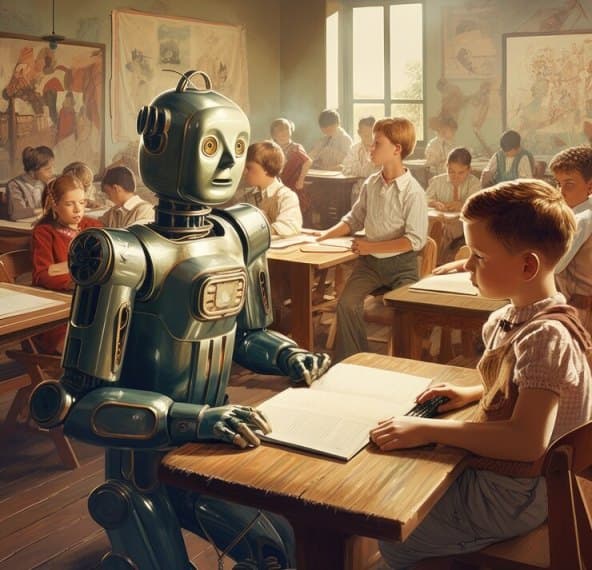Artificial intelligence (AI) is revolutionizing education by offering personalized learning experiences and automating administrative tasks. Despite these benefits, AI introduces several negative effects. Students may become overly dependent on AI, leading to reduced critical thinking and problem-solving abilities. There is also the risk of data privacy issues, as AI systems collect vast amounts of personal information.
Additionally, the use of AI in education could widen the digital divide, disadvantaging students without access to advanced technology. Educators must balance the advantages of AI with its potential drawbacks to create a comprehensive and equitable learning environment.
11 Negative Effects of Artificial Intelligence in Education
AI in education comes with several potential negative effects. Below is an overview of the key concerns:
1. Decreased Critical Thinking and Problem-Solving Skills
One of the most alarming negative effects of AI in education is the erosion of critical thinking and problem-solving skills. AI-powered tools like automated essay graders, adaptive learning platforms, and personalized tutoring systems may streamline learning processes, but they risk oversimplifying complex cognitive tasks.
When students rely too heavily on AI-driven tools, they are less likely to engage in deep learning processes, such as analyzing problems, generating solutions, and evaluating arguments.
This over-reliance on AI leads to passive learning, where the students’ ability to think critically and solve problems independently may diminish.
The long-term result is a generation of learners who are proficient in following AI-generated instructions but struggle to apply creative and independent thought to real-world challenges.
2. Privacy Concerns
Artificial Intelligence collects a lot of student data. This data can include test scores, behavior, and even personal information. Schools use this data to help students learn better. But, it can also cause privacy problems.
If the data is not protected, it can be hacked or misused. Parents and students worry about who can see this data. They also worry about how the data is used. This can make students feel unsafe.
Some schools use AI to watch students. Cameras and software can track where students go. They can also see what students do. This is called student surveillance. It can help keep schools safe.
But, it can also make students feel like they are always being watched. This can cause stress and anxiety. Students may feel like they have no privacy. They might not feel free to express themselves.
Read Also: What is an Alternative to Traditional Face to Face Teaching?
3. Bias And Discrimination
Artificial Intelligence can sometimes show bias. This means it can treat some students unfairly. It can happen because the data used to train AI is not balanced.
If more data comes from one group, the AI may favor that group. This can make learning harder for some students. They might not get the same opportunities as others. Teachers need to be careful when using AI tools. Checking for bias is very important.
Not all students have the same access to AI tools. Rich schools can buy more advanced technology. This leaves poor schools behind. Students in poor schools may not get the same learning experiences. This can make the education gap even bigger. Everyone should have the same chance to learn. Schools need to find ways to share technology.
4. Job Displacement
Artificial Intelligence can replace some teachers. This can lead to teacher redundancy. Many teachers may lose their jobs.
AI can teach students using smart tools. These tools can offer personalized learning. But the human touch is missing. Students may feel less connected. They might miss the warmth of a real teacher.
AI can also take over administrative roles. Tasks like scheduling and grading can be automated. This can reduce the need for administrative staff.
Many people might lose their jobs. The school environment might change. Human interaction can decrease. This can make schools feel less personal.
5. Loss of Teacher Independence
As AI systems become more advanced and integrated into classrooms, there is a growing risk of diminishing teacher autonomy. Educators may feel pressured to conform to AI-generated lesson plans, assessments, and feedback systems, leaving them less room to tailor their instruction to the unique needs of their students.
While AI can serve as a supportive tool, it can also become a crutch, limiting teachers’ ability to implement creative, innovative pedagogical methods.
The dependence on AI-driven instructions can reduce teachers’ role as facilitators of learning, shifting their responsibilities towards mere supervisors of technology.
In the long term, this could devalue the professional expertise of teachers and their critical role in shaping the future of education.
6. Dependency On Technology
As AI tools become more prevalent in classrooms, there is a risk of over-dependence on technology in education. While AI can assist in automating tasks such as grading, providing feedback, and creating lesson plans, it may encourage educators and institutions to relinquish too much control to machines. This shift could result in the reduction of creative teaching methods and an overreliance on AI algorithms that may not always adapt to every learner’s unique needs.
Students, too, may become overly dependent on AI for guidance and answers, failing to develop essential learning strategies like self-regulation and metacognition.
The loss of traditional learning methods, such as engaging with a text independently or collaborating with peers to solve problems, can stunt cognitive development and reduce students’ abilities to navigate challenges without technological assistance.
7. High Implementation Expenses
Implementing AI-driven technologies in education requires substantial financial investments. Schools and educational institutions must allocate significant budgets for AI software, hardware upgrades, and ongoing maintenance. Additionally, there are costs associated with training teachers and staff to effectively use these tools.
While AI promises long-term benefits, the initial costs of integrating these technologies can be prohibitive, particularly for public schools and underfunded institutions. This could lead to an unequal distribution of AI resources, where only wealthier schools can afford advanced AI tools, further widening the educational gap between affluent and low-income students.
8. Mental Health Impact
Artificial intelligence can cause increased stress in students. Automated systems may create pressure to perform better. Students might feel they are being constantly watched. This can lead to anxiety and stress.
AI tools can result in social isolation. Students may spend more time alone with technology. Lack of human interaction affects their social skills. They might feel lonely and disconnected from friends. Social isolation can impact mental health.
9. Quality Of Education
AI often pushes for standardized teaching methods. This can make learning rigid and less flexible. Every student learns differently, but AI can’t always adapt. This can lead to boredom and disengagement in students. They may feel like they are just another number in the system.
AI can fail to understand individual student needs. This results in a loss of personalized learning. Some students need extra help or different methods. AI might not provide this.
Students can feel left behind or unnoticed. Personal connections with teachers are also important. AI can’t replace the human touch in education.
10. Technical Difficulties
AI systems are not immune to technical glitches, malfunctions, or software bugs. When technical issues arise in the middle of a learning session, they can disrupt the educational process, causing frustration for both students and teachers. Additionally, frequent downtime or system errors can make it difficult for schools to rely on AI as a consistent tool for instruction.
Moreover, many AI systems require regular updates and technical support, placing further demands on schools’ IT infrastructure. Educators who are not well-versed in technology may struggle with troubleshooting, leading to delays in the learning process and a potential loss of instructional time.
11. Cyber Attacks and Data Breaches
As educational institutions adopt more AI-powered technologies, they become increasingly vulnerable to cyber-attacks. AI systems that collect and store sensitive student information — such as academic records, personal details, and behavioral data — are attractive targets for cybercriminals. A data breach can expose students to identity theft and other forms of exploitation.
Additionally, cyber-attacks may disrupt educational operations, leading to compromised learning environments and financial losses for schools. To protect against these risks, institutions must invest heavily in cybersecurity measures, which can further increase the overall cost of AI implementation.
Final Thoughts
The integration of artificial intelligence in education undoubtedly brings both innovation and efficiency. As AI becomes more prevalent, it is essential for educational institutions to carefully balance its benefits with its potential drawbacks.
To ensure that AI enhances rather than detracts from the educational experience, schools must adopt a thoughtful and cautious approach, focusing on protecting data privacy, addressing ethical challenges, and preserving the human connection that is vital to effective learning. Only by doing so can we harness the true potential of AI while safeguarding the integrity of education.



